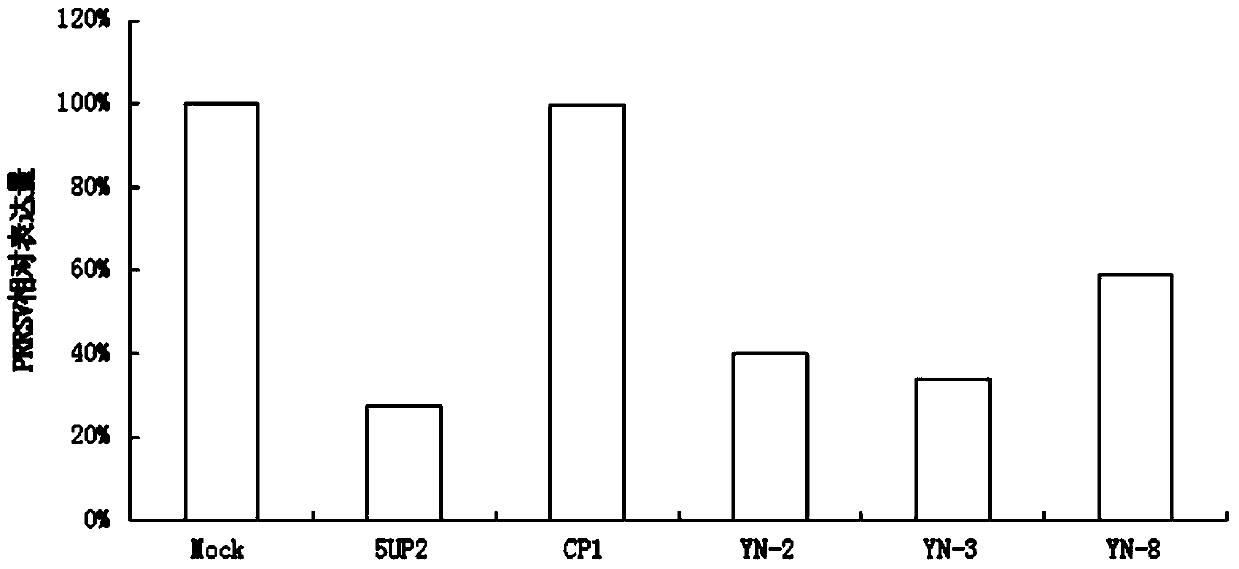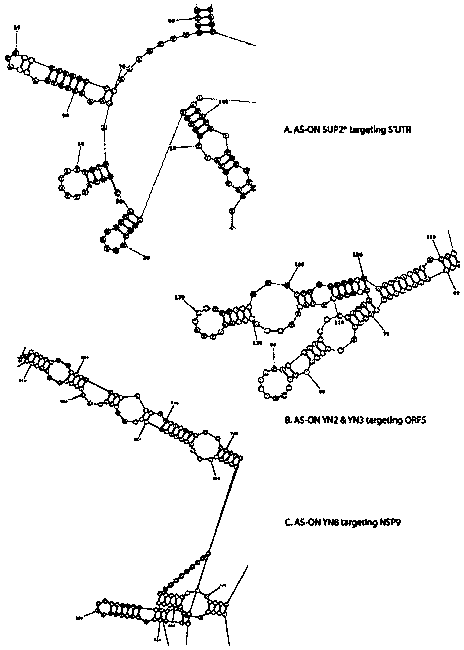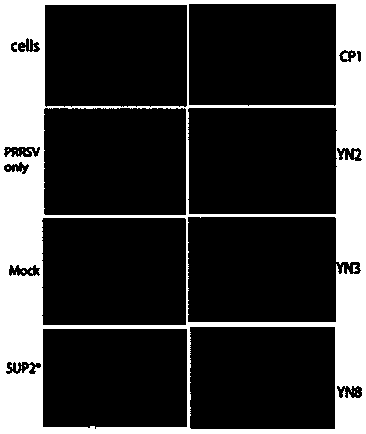Antisense DNA (Deoxyribose Nucleic Acid) sequence for treating and preventing porcine reproductive and respiratory syndrome and application thereof
A respiratory syndrome and DNA sequence technology, applied in recombinant DNA technology, DNA / RNA fragments, gene therapy, etc., can solve problems such as outbreaks, atypical PRRS epidemics, vaccine safety and efficiency, and achieve low toxicity and side effects. The effect of significant curative effect and moderate cost
- Summary
- Abstract
- Description
- Claims
- Application Information
AI Technical Summary
Problems solved by technology
Method used
Image
Examples
Embodiment 1
[0023] Embodiment 1: the design of antisense DNA
[0024] Antisense DNA design strategy: 1) Completely predict the primary secondary structure and secondary secondary structure of mRNA, and these structure predictions mainly follow the minimum free energy, not in the folding region. Find the single-stranded region as much as possible. If the length of the single-stranded region is not enough, both ends can extend to the double-stranded region; 2) The length of the antisense nucleic acid requires 20nt. Generally, the start codon (AUG) or the 20-base sequence near it is selected, or at both ends of the mRNA, or the neck loop structure, as far as possible in the single-stranded region; 3) Try to contain CCAC, TCCC, ACTC, GCCA or CTCT bases, these bases help to enhance the effect of antisense nucleic acid; 4) CG content also helps antisense nucleic acid to play a role, control G+C content between 40% and 60%; 5) Select RNA two The unstable part in the secondary structure is used ...
Embodiment 2
[0034] Example 2: Antisense DNA inhibits viral cytopathic effect
[0035]1. Digest the well-grown Marc-145 cells with 0.25% porcine trypsin, count, then add 1×104 cells / well, 100 μl per well, into a 96-well culture plate, and place the cells in a carbon dioxide incubator Grow to a single layer and set aside. The antisense DNA of each experimental group is within the maximum non-toxic dose range (TM 2000 transfected into Marc-145 cells, replaced with normal medium after 4 hours, cultured in 37°C, 5% CO2 incubator, and continuously cultivated for 60 hours, observed the degree of cell lesion in each experimental group day by day, and compared with the normal cell control group compared with the virus control group.
[0036] 2. The result is as follows figure 2 As shown, a variety of antisense DNA and positive and negative control antisense DNA sequences were transfected into Marc-145 cells inoculated with PRRSV and cultured continuously for 60 hours. It can be seen that YN-2, ...
Embodiment 3
[0037] Embodiment 3: antisense DNA suppresses PPRSV mRNA expression level analysis
[0038] 1. Digest well-grown Marc-145 cells with 0.25% porcine trypsin, count them, and count them according to 1×10 4 Cells were cultured at the density of each well, 100 μl per well, added to a 96-well culture plate, and placed in a carbon dioxide incubator until the cells grew to a monolayer, ready to use. Using 25 TCIDs 50 The YN-1 strain PRRS virus per well was inoculated into the cells, and after the virus was incubated for 1.5h, 32 μM antisense DNA (within the non-toxic dose range) of each experimental group was used Lipofectamine TM 2000 transfected into Marc-145 cells, changed to 5% DMEM complete medium after 4h, 37°C, 5% CO 2 Cells were harvested after continuous culture in the incubator for 60 hours, RNA was extracted, and then reverse-transcribed into cDNA. Finally, real-time fluorescent quantitative PCR was used to detect the effects of different concentrations of antisense DNA o...
PUM
 Login to View More
Login to View More Abstract
Description
Claims
Application Information
 Login to View More
Login to View More - R&D
- Intellectual Property
- Life Sciences
- Materials
- Tech Scout
- Unparalleled Data Quality
- Higher Quality Content
- 60% Fewer Hallucinations
Browse by: Latest US Patents, China's latest patents, Technical Efficacy Thesaurus, Application Domain, Technology Topic, Popular Technical Reports.
© 2025 PatSnap. All rights reserved.Legal|Privacy policy|Modern Slavery Act Transparency Statement|Sitemap|About US| Contact US: help@patsnap.com



